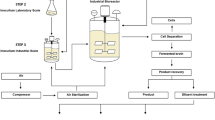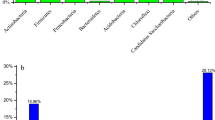Abstract
The bioaugmentation of petroleum-contaminated soil using Enterobacter cloacae was profiled from the evolution of microbial community, soil dehydrogenase activity, to the degradation of petroleum contaminants. The seeding and proliferation of inoculant and the consequential microbial community were monitored by denaturing gradient gel electrophoresis analysis of the amplification of V3 zone of 16S rDNA. Degradation process kinetics was characterized by the degradation ratio of nC17 to nC18. The dehydrogenase activity was also determined during the degradation process. An abrupt change in the microbial community after inoculation was illustrated as well as successive changes in response to degradation of the petroleum contaminants. Seeding with E. cloacae stimulated the growth of other degrading stains such as Pseudomonas sp. and Rhodothermus sp. The application of wheat straw as a representative lignin waste, at 5% (w/w), induced an increase in the total dehydrogenase activity from 0.50 to 0.79, an increase in the microbial content of 130% for bacteria and 84% for fungi, and an increase of the overall degradation ratio from 44% to 56% after 56 days of treatment. The above mentioned results have provided a microbial ecological insight being essential for the design and implementation of bioaugmentation processes.







Similar content being viewed by others
References
Kästner, M., & Marho, B. (1996). Applied Microbiology and Biotechnology, 44, 668–675.
Swannell, R. P., & Head, I. M. (1994). Nature, 368, 396–397.
Thompson, I. P., van der Gast, C. J., Ciric, L., & Singer, A. C. (2005). Environmental Microbiology, 7, 909–915.
Gentry, T. J., Rensing, C., & Pepper, I. L. (2004). Critical Reviews in Environmental Science and Technology, 34, 447–494.
El Frantroussi, S., & Agathos, S. N. (2005). Current Opinion in Microbiology, 8, 268–275.
Dejonghe, W., Boon, N., Seghers, D., Top, E. M., & Verstraete, W. (2001). Environmental Microbiology, 3, 649–657.
Roane, T. M., Josephson, K. L., & Pepper, I. L. (2001). Applied and Environmental Microbiology, 67, 3208–3215.
Elis, D. E., Lutz, E. J., Odom, J. M., Buchanan, R. J., Bartlett, C. L., Lee, M. D., et al. (2000). Environmental Science & Technology, 34, 2254–2260.
Vogel, T. M. (1996). Current Opinion in Biotechnology, 7, 311–316.
Han, H. L., Tang, J., Jiang, H., Zhang, M. L., & Liu, Z. (2008). Environmental Science (in Chinese), 29, 189–195.
Han, H. L., Chen, Z., Yang, J. M., Miao, C. C., Zhang, K., Jin, W. B., et al. (2008). Environmental Science (in Chinese), 29, 184–191.
Zhang, K., Hua, X. F., Han, H. L., Wang, J., Miao, C. C., Xu, Y. Y., et al. (2008). Chemosphere, 73, 1387–1392.
Callaham, M. A., Stewart, A. J., Alarcon, C., & McMillen, S. J. (2002). Environmental Toxicology and Chemistry, 21, 1658–1663.
Stevenson, F. J. (1994). Humus chemistry: genesis composition, reactions (2nd ed., pp. 24–34). Berlin: Springer.
Hofrichter, M., & Steinbüchel, A. (2001). Biopolymers, volume 1: lignin, humic substances and coal (pp. 24–34). Weinheim: Wiley.
Li, H., Zhang, Y., Zhang, C. G., & Chen, G. X. (2005). Journal of Environmental Quality, 34, 1073–1080.
Li, H., Zhang, Y., Irina, K., Xu, H., & Mang, C. G. (2007). Journal of Environmental Sciences (China), 19, 1003–1013.
Wilfred, F. M., Michael, G. M., Martin, J., Francesco, F., Richard, P. J. S., Fabien, D., et al. (2004). Applied and Environmental Microbiology, 70, 2603–2613.
Marc, V., Jordi, S., & María, J. (2005). Applied and Environmental Microbiology, 71, 7008–7018.
Coppotelli, B. M., Ibarrolaza, A., Del Panno, M. T., & Morelli, I. S. (2008). Microbial Ecology, 55, 173–183.
Katsivela, E., Moore, E. R. B., Maroukli, D., Strompl, C., Pieper, D., & Kalogerakis, N. (2005). Biodegradation, 16, 169–180.
Denaro, R., Auria, G. D., Di Marco, G., Genovese, M., Troussellier, M., Yakimov, M. M., et al. (2005). Environmental Microbiology, 7, 78–87.
Zhou, J. Z., Bruns, M. A., & Tiedje, J. M. (1996). Applied and Environmental Microbiology, 62, 316–322.
Yan, S. T., Miyanaga, K., Xing, X. H., & Tanji, Y. (2008). Biochemical Engineering Journal, 39, 598–603.
Muyzer, G., Ellen, D. W., & Ander, G. U. (1993). Applied and Environmental Microbiology, 59, 695–700.
Shen, P., Fan, X. F., & Li, G. W. (1999). Microbiology experiment (3rd ed., pp. 92–95). Beijing: Higher Education.
Hua, X. F., Wang, J., Wu, Z. J., Zhang, H. X., Li, H. P., Xing, X. H., et al. (2010). Biochemical Engineering Journal, 49, 201–206.
Li, B.M. (2007). Microbial remediation of oil contaminated soil. Dissertation, Soil and Fertilizer Institute, Chinese Academy of Agricultural Sciences.
Ishihara, A., Dumeignil, F., Aoyagi, T., Nishikawa, M., Hosomi, M., Qian, E. W., et al. (2008). Journal of the Japan Petroleum Institute, 51, 174–179.
Suzuki, S., & Hiraishi, A. (2007). The Journal of General and Applied Microbiology, 53, 221–228.
Morgante, V., Lopez-Lopez, A., Flores, C., Gonzalez, M., Gonzalez, B., Vasquez, M., et al. (2010). FEMS Microbiology Ecology, 71, 114–126.
Sako, Y., Takai, K., Ishida, Y., Uchida, A., & Katayama, Y. (1996). International Journal of Systematic Bacteriology, 46, 1099–1104.
Acknowledgments
This study was financially supported by the China Petroleum and Chemical Corporation. The authors would like to extend their thanks to Prof. Xinhui Xing at the Department of Chemical Engineering, Tsinghua University for his productive comments.
Author information
Authors and Affiliations
Corresponding author
Rights and permissions
About this article
Cite this article
Wu, Z., Dong, H., Zou, L. et al. Enriched Microbial Community in Bioaugmentation of Petroleum-Contaminated Soil in the Presence of Wheat Straw. Appl Biochem Biotechnol 164, 1071–1082 (2011). https://doi.org/10.1007/s12010-011-9195-1
Received:
Accepted:
Published:
Issue Date:
DOI: https://doi.org/10.1007/s12010-011-9195-1




